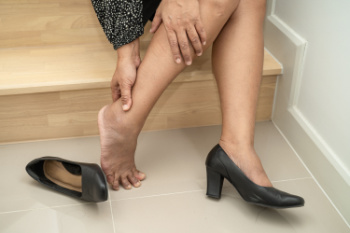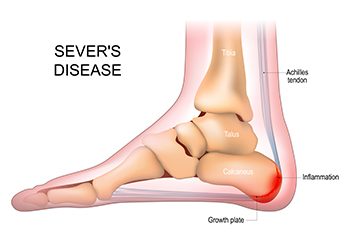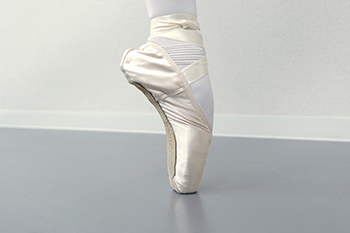Items filtered by date: December 2024
Foot and Ankle Pain Can Be Warnings

Foot and ankle pain can range from mild discomfort to a serious issue that disrupts daily life. Persistent or worsening foot pain should not be ignored, as it may indicate conditions like arthritis, tendon injuries, or even nerve damage. For example, arthritis in the foot or ankle often causes stiffness and swelling, which limits mobility and affects daily activities. Tendon injuries or conditions like acquired flatfoot can result in pain on the inside of the foot or ankle, often becoming worse with activity. Another common concern is heel pain, stemming from a heel spur, which is a calcium deposit that can irritate nearby tissues. Pain in the big toe can severely affect the way you walk, leading to harmful gait and posture changes. A podiatrist is skilled in diagnosing and managing foot, toe, and ankle-related conditions. Treatment solutions may include custom orthotics, injections, or, when necessary, surgery. If you have foot, toe, or ankle pain, it is suggested that you schedule an appointment with a podiatrist for an exam and diagnosis.
Foot Pain
Foot pain can be extremely painful and debilitating. If you have a foot pain, consult with Dr. Richard T. Bauer from Summit Foot & Ankle. Our doctor will assess your condition and provide you with quality foot and ankle treatment.
Causes
Foot pain is a very broad condition that could be caused by one or more ailments. The most common include:
- Bunions
- Hammertoes
- Plantar Fasciitis
- Bone Spurs
- Corns
- Tarsal Tunnel Syndrome
- Ingrown Toenails
- Arthritis (such as Gout, Rheumatoid, and Osteoarthritis)
- Flat Feet
- Injury (from stress fractures, broken toe, foot, ankle, Achilles tendon ruptures, and sprains)
- And more
Diagnosis
To figure out the cause of foot pain, podiatrists utilize several different methods. This can range from simple visual inspections and sensation tests to X-rays and MRI scans. Prior medical history, family medical history, and any recent physical traumatic events will all be taken into consideration for a proper diagnosis.
Treatment
Treatment depends upon the cause of the foot pain. Whether it is resting, staying off the foot, or having surgery; podiatrists have a number of treatment options available for foot pain.
If you have any questions, please feel free to contact our office located in Latham, NY . We offer the newest diagnostic and treatment technologies for all your foot care needs.
Daily Yoga Foot Stretches for Better Flexibility

Incorporating yoga foot stretches into your daily routine can greatly improve flexibility, strength, and overall foot health. One simple stretch involves sitting on the floor and stretching your legs out in front of you. Reach for your toes, gently pulling them back toward your body to stretch the soles and calves. Another effective stretch is the downward-facing dog, which lengthens the hamstrings, calves, and arches of the feet. For a more targeted stretch, try the toe stretch, where you kneel and gently stretch your toes by placing your feet flat on the floor and sitting back onto your heels. Lastly, the seated foot stretch involves sitting with one leg crossed over the other and using your hands to gently pull the toes back, stretching the top of the foot. If you have developed foot pain, it is suggested that you consult a podiatrist who can treat various foot conditions, and guide you on additional effective foot stretches.
Stretching the feet is a great way to prevent injuries. If you have any concerns with your feet consult with Dr. Richard T. Bauer from Summit Foot & Ankle. Our doctor will assess your condition and provide you with quality foot and ankle treatment.
Stretching the Feet
Stretching the muscles in the foot is an important part in any physical activity. Feet that are tight can lead to less flexibility and make you more prone to injury. One of the most common forms of foot pain, plantar fasciitis, can be stretched out to help ease the pain. Stretching can not only ease pain from plantar fasciitis but also prevent it as well. However, it is important to see a podiatrist first if stretching is right for you. Podiatrists can also recommend other ways to stretch your feet. Once you know whether stretching is right for you, here are some excellent stretches you can do.
- Using a foam roller or any cylindrical object (a water bottle or soda can will do), roll the object under your foot back and forth. You should also exert pressure on the object. Be sure to do this to both feet for a minute. Do this exercise three times each.
- Similar to the previous one, take a ball, such as a tennis ball, and roll it under your foot while seated and exert pressure on it.
- Grab a resistance band or towel and take a seat. If you are using a towel, fold it length wise. Next put either one between the ball of your foot and heel and pull with both hands on each side towards you. Hold this for 15 seconds and then switch feet. Do this three times for each foot.
- Finally hold your big toe while crossing one leg over the other. Pull the toe towards you and hold for 15 seconds. Once again do this three times per foot.
It is best to go easy when first stretching your foot and work your way up. If your foot starts hurting, stop exercising and ice and rest the foot. It is advised to then see a podiatrist for help.
If you have any questions, please feel free to contact our office located in Latham, NY . We offer the newest diagnostic and treatment technologies for all your foot care needs.
Heel Pain Can Be Treated!
Sever’s Disease Help

Sever’s disease is a common cause of heel pain in growing children and adolescents, especially those active in sports. It occurs when the growth plate in the heel bone, known as the calcaneus, becomes inflamed due to repetitive stress and tension from the Achilles tendon. Symptoms include heel pain, swelling, and difficulty walking, particularly after physical activity. A podiatrist can help in managing Sever’s disease. They can accurately diagnose the condition, ruling out other causes of heel pain. Treatment often includes customized orthotics, heel lifts, or cushioning to reduce stress on the growth plate. They may also recommend stretching exercises to improve flexibility in the calf and Achilles tendon. Activity modification or temporary rest from sports might be advised. If your child has persistent heel pain, it is suggested that you visit a podiatrist to ease their discomfort and prevent long-term complications.
Sever's disease often occurs in children and teens. If your child is experiencing foot or ankle pain, see Dr. Richard T. Bauer from Summit Foot & Ankle. Our doctor can treat your child’s foot and ankle needs.
Sever’s Disease
Sever’s disease is also known as calcaneal apophysitis, which is a medical condition that causes heel pain I none or both feet. The disease is known to affect children between the ages of 8 and 14.
Sever’s disease occurs when part of the child’s heel known as the growth plate (calcaneal epiphysis) is attached to the Achilles tendon. This area can suffer injury when the muscles and tendons of the growing foot do not keep pace with bone growth. Therefore, the constant pain which one experiences at the back of the heel will make the child unable to put any weight on the heel. The child is then forced to walk on their toes.
Symptoms
Acute pain – Pain associated with Sever’s disease is usually felt in the heel when the child engages in physical activity such as walking, jumping and or running.
Highly active – Children who are very active are among the most susceptible in experiencing Sever’s disease, because of the stress and tension placed on their feet.
If you have any questions, please feel free to contact our office located in Latham, NY . We offer the newest diagnostic and treatment technologies for all your foot and ankle injuries.
How Pointe Shoes Can Complicate the Biomechanics of Ballet

Pointe shoes are essential for many ballet dancers, allowing them to perform on the tips of their toes, creating an ethereal, floating appearance. However, wearing pointe shoes can complicate the biomechanics of ballet. These shoes shift the body’s natural alignment, often altering the way dancers move and place weight on their feet. The rigid structure of the shoe prevents the foot from flexing and distributing force evenly across the foot and ankle, leading to increased pressure on the toes and forefoot. Over time, this unnatural positioning can lead to imbalances, pain, and even injury. Furthermore, the added strain on the feet and lower limbs can cause overuse injuries in muscles, tendons, and joints. If you have developed foot pain from ballet dancing on pointe, it is suggested that you consult a podiatrist who can offer effective treatment solutions.
If you have any concerns about your feet, contact Dr. Richard T. Bauer from Summit Foot & Ankle. Our doctor can provide the care you need to keep you pain-free and on your feet.
Biomechanics in Podiatry
Podiatric biomechanics is a particular sector of specialty podiatry with licensed practitioners who are trained to diagnose and treat conditions affecting the foot, ankle and lower leg. Biomechanics deals with the forces that act against the body, causing an interference with the biological structures. It focuses on the movement of the ankle, the foot and the forces that interact with them.
A History of Biomechanics
- Biomechanics dates back to the BC era in Egypt where evidence of professional foot care has been recorded.
- In 1974, biomechanics gained a higher profile from the studies of Merton Root, who claimed that by changing or controlling the forces between the ankle and the foot, corrections or conditions could be implemented to gain strength and coordination in the area.
Modern technological improvements are based on past theories and therapeutic processes that provide a better understanding of podiatric concepts for biomechanics. Computers can provide accurate information about the forces and patterns of the feet and lower legs.
Understanding biomechanics of the feet can help improve and eliminate pain, stopping further stress to the foot.
If you have any questions please feel free to contact our office located in Latham, NY . We offer the newest diagnostic and treatment technologies for all your foot and ankle needs.
Underlying Factors of Swollen Toes

Swollen toes can result from various causes, ranging from injury to underlying health conditions. One of the most common reasons is trauma, such as a sprain or fracture, which can cause immediate swelling, pain, and bruising. Infections like cellulitis or ingrown toenails can also lead to localized swelling, often accompanied by redness and tenderness. Conditions such as gout, where uric acid crystals build up in the joints, can cause intense swelling and discomfort in the toes. In addition, circulatory problems, such as poor blood flow or heart disease, can cause fluid retention in the extremities, leading to swelling. Other causes may include inflammatory conditions like arthritis or certain medications that contribute to fluid buildup. If one or more toes are swollen, it is suggested that you consult a podiatrist who can determine what the cause is, and offer appropriate treatment solutions.
Toe pain can disrupt your daily activities. If you have any concerns, contact Dr. Richard T. Bauer of Summit Foot & Ankle. Our doctor can provide the care you need to keep you pain-free and on your feet.
What Causes Toe Pain?
Most severe toe pain is caused due to a sports injury, trauma from dropping something heavy on the toe, or bumping into something rigid. Other problems can develop over time for various reasons.
Toe pain can be caused by one or more ailments. The most common include:
- Trauma
- Sports injury
- Wearing shoes that are too tight
- Arthritis
- Gout
- Corns and calluses
- Hammertoe
- Bunions
- Blisters
- Ingrown toenails
- Sprains
- Fractures (broken bones)
- Dislocations
When to See a Podiatrist
- Severe pain
- Persistent pain that lasts more than a week
- Signs of infection
- Continued swelling
- Pain that prevents walking
Diagnosis
In many cases the cause of toe pain is obvious, but in others, a podiatrist may want to use more advanced methods to determine the problem. These can range from simple visual inspections and sensation tests to X-rays and MRI scans. Prior medical history, family medical history, and any recent physical traumatic events will all be taken into consideration for a proper diagnosis.
Treatment
Treatments for toe pain and injuries vary and may include shoe inserts, padding, taping, medicines, injections, and in some cases, surgery. If you believe that you have broken a toe, please see a podiatrist as soon as possible.
If you have any questions please feel free to contact our office located in Latham, NY . We offer the newest diagnostic tools and technology to treat your foot and ankle needs.

